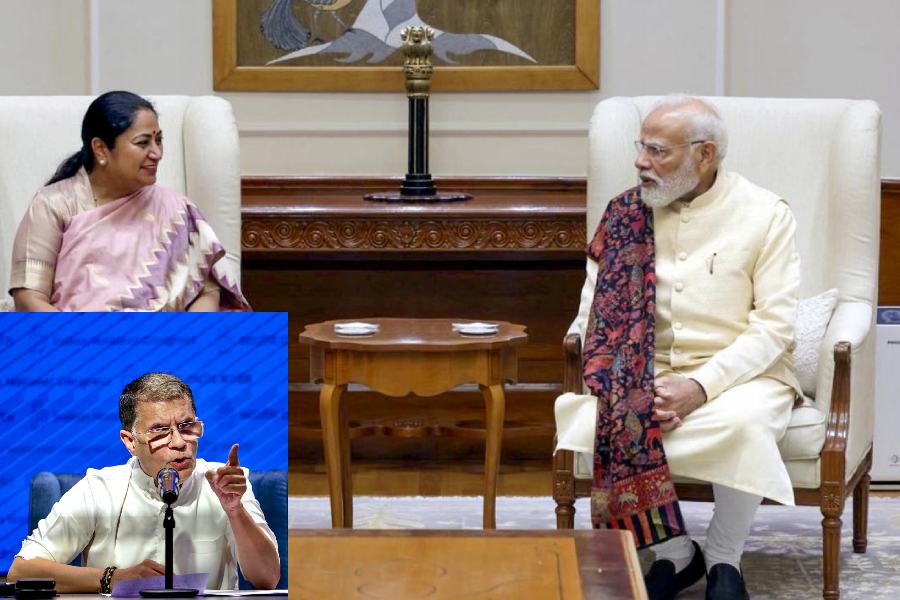 |
S atyendra Pakhale has designs on the world — and far beyond. So, if you had stopped at the recent Milan Design Week you’d have spotted the model for a futuristic kitchen created by the globally renowned industrial designer. The centrepiece of Pakhale’s cheery red kitchen was a smartphone controlled oven made by Franke, a Swiss kitchen appliance maker. But even more crucially, Pakhale had squeezed the entire kitchen into tiny 27sqft— his answer to the growing premium on space.
Cut to another design exhibition in Pakhale’s adopted home town Amsterdam. Here Pakhale is looking into outer space. On display is the Moonwaka, an object resembling a hiking staff that he has designed to help space travellers orient themselves as they walk in the moon’s microgravity environment.
“Design is the synthesis of the artistic, the cultural and the humanistic with technology. And I’m fascinated by all of these,” says Pakhale, who’s originally from a small town named Washim near Aurangabad.
For the last 20 years, Pakhale has been wowing the world with his wide-ranging industrial design work. As an industrial designer, Pakhale has spread his skills wide working with everyone from kitchen equipment makers to luxury goods companies. And he has designed everything from the innovative, almost sculptural-looking Add-On Radiator, which blends into the architecture, to household objects like his Akasma line of bent-glass bowls and trays. At an altogether different level, he earned considerable fame by creating his famous B.M. Horse Chair, which is inspired by the bell metal craft of the Bastar tribals.
“The aim is to create innovative ideas and technologically advanced solutions that hit a cultural chord,” says the 45-year-old designer, who began his career at Philips Design in the mid-1990s.
Today, Pakhale’s works are in the permanent collections of prestigious museums like the Centre Pompidou, Paris, and the Victoria and Albert Museum, London. And at the recent Milan Design Week’s SaloneSatellite segment, he was among 15 leading international designers invited to make presentations on Design & Technology, an area that deeply interests him.
Pakhale’s clients include leading European design manufacturing firms like Cappellini, Alessi, Tubes and Magis, and he works from his studio in Amsterdam. He usually restricts himself to 12-14 projects at a time.
Now, he plans to make his mark in India. He was among the key speakers at the inaugural India Design Forum in Delhi earlier this year. And he’s hoping to undertake projects for manufacturing companies and also design projects on environmentally and socially conscious issues.
Pakhale’s constantly forging new paths. So, he’s working on architectural projects in Switzerland and the Netherlands next. Then, there’s the Moonwaka which was created after he was invited to participate in a project that investigated the challenges of living on the moon.
He believes that space travel will become as common as air travel today. “But without any extensive astronautical training, how do you orient yourself because perception and the angle of vision changes in microgravity,” he explains. Hence, the Moonwaka has a viewfinder to assist eye-hand coordination while walking on the moon.
Pakhale’s charting new ground in other ways. For instance, the hot debate at the Milan Design Week was about striking a balance between digitalised manufacturing and hand-crafting. But, Pakhale’s already mastered this balancing act with his famous B.M. Horse Chair, in which he combined the lost-wax casting process used by the Bastar tribals with hi-tech manufacturing processes and materials.
Pakhale spent seven-and-a-half years creating the sculptural bronze chair, which is now a collector’s piece. He started the project soon after setting up his firm in 1998 because he felt that mass-produced industrial products lack the tactile quality of hand-crafted objects. “In the world of technology, we sometimes lose the sensorial qualities of touch and feel. So, I wanted to go back to the basics,” says Pakhale. He worked with the tribals and also roped in high-tech manufacturers. He initially tried to produce the chair at a sculptor’s studio in Nagpur but eventually moved the project to Europe. The result: the chair was an instant hit when presented at Design Miami Basel in 2007.
Pakhale has since created other limited edition pieces like the B.M. Horse Stool, which is in the V&A collection, the Kubu lounge and the Flower Offering Chair.
Pakhale’s keen to use traditional skills but he’s also constantly dealing in new technologies. “I’m always looking at creating something which is shaped by new technologies,” he says. For instance, he made his iconic Fish Chair with a surface coating that was initially used to line aeroplane fuel tanks.
His industrial products have also received recognition. The Add-On Radiator won the Red Dot, the biggest international design award, in 2008 and is in the Centre Pompidou’s permanent design collection. What’s more, it’s a commercial success.
Pakhale’s father was a professor of math and physics and his mother was also a teacher. “As much as I grew up in an intellectual environment and amidst art and culture, my education was also geared towards the technology of making things,” he says.
He remembers always drawing and making things as a child. “My parents sent me to a vocational school which nurtured this,” he says. After studying at the Technical High School in Nagpur, he did mechanical engineering at the Visvesvaraya National Institute of Technology, Nagpur. That’s where he first learnt about industrial design, and went on to get a master’s degree at IIT Mumbai’s Industrial Design Centre (IDC). “IDC was a great experience,” recalls Pakhale. He then won a scholarship to study Advanced Product Design at the Art Center College of Design in Switzerland in 1992. “It was amazing since all the top designers and industry heads came to teach there. So, I did a lot of projects for industry from the beginning,” says Pakhale. For instance, he interned with Frog Design, the iconic firm that designed the first Apple Macintosh computer.
When Pakhale started work in 1994, Silicon Valley was emerging as the Mecca for technology and design. He had offers from there but decided to join Philips Design in its New Business Creation unit in Europe. “It was a small but highly regarded team,” he says. He worked here on many “technologies that were far ahead of their times” like smartphones. “It’s very rare that a designer gets these opportunities right away. But my early experience was at a highly sophisticated level of industry,” he says.
By 1998, Pakhale decided to start his own outfit. His first projects were with Italian companies. For instance, he designed his Akasma line of bent-glass bowls for Italian firm RSVP. Another early work was the Kalpa vase inspired by Indian claypots for the Dutch company Cor Unum. Soon, he was doing projects for other leading design manufacturing firms like Bosa, Moroso, Offect and Cappellini.
His practice has grown since in scale and scope. For instance, he designed for the luxury shoe brand TOD’s flagship store in New York. Last year, his installation using a high-tech material called Alcantara was unveiled at the new Maxxi museum in Rome.
Now, he’s eager to explore “new possibilities”, especially in India, even as he continues doing what he’s best at: “synthesise technology and craft and culture”. “Design is an adventure. You have to believe in yourself,” says Pakhale. He’s certainly enjoying the ride. u










